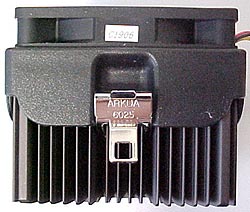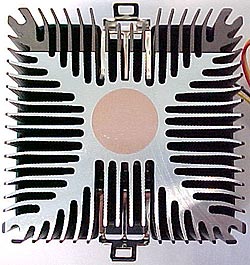
|
|
82%
Abstract: From the users perspective, the 7528 is quieter, and offers comparable performance because it is based on the same underlying metal fin assembly.
|
Home >
Reviews >
Page: Looking at the heatsink from all angles
|
| Arkua 7528 Heatsink From
All Angles |
 |
The Fan:
Where the 7228 uses a 60mm fan, the 7528 uses
a lower RPM, 70mm fan that doesn't produce nearly as much noise
- or cooling power for that matter. The fan connects to the motherboard fan
header via a 3-pin connector which also supports RPM monitoring. |
 |
Heatsink Top:
The core of the 7528 is actually cut away so
that the copper slug is roughly half the height of the entire fin section. The plastic fan
shroud that surrounds the upper layer holds the fan centered in place, and directs
the airflow down amongst the fins. Each of the aluminum fins is
scalloped to ensure good turbulence, and improved heat transfer. Fins are spaced
2-2.5mm apart and are typically 1mm thick. |
 |
Side A:
The little recess in the fan shroud makes
getting at the clip fool proof, and in fact the clip design works a heck of
a lot better than the original Thermosonic coolers ever did. The clip requires the use of a
flat head screw driver, but is pretty easy to engage, and holds the entire unit
securely. The fan shroud extends down about 24mm, leaving 26mm worth of fin exposed for airflow to exhaust
out from. |
 |
Side B:
The name of the manufacturer is
on the other side of the heatsink, which is identical
to the above side except for the lack of a clip
system. The fins are spaced about 2.5mm apart and are slightly
tapered. |
 |
Heatsink Base:
Marvel in its glory for this is the
Arkua 7528 is what should be written
on the box of this heatsink. The star pattern and fin design works
efficiently to move heat away from the processor as downward air keeps everything nice
and cool. The base is machined perfectly flat and is very smooth, though not polished.
A little bit of thermal compound is recommended. The copper core is 24mm in
diameter, and the base undercut to allow clearance for socket cam arms.
|
|
 |
Websites you may also like:
PCSTATS
|
|
 |


